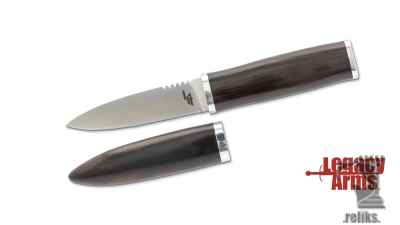Scottish Dirk
The Scottish dirk is a traditional Scottish weapon that has been in use for centuries. It is a dagger-like weapon that has a single-edged blade and a long hilt that can be used for striking, hooking, and parrying. It was commonly used by the Scottish Highlanders as a self-defense weapon during the 16th and 17th centuries.
The sgian dubh is a perfect way to compliment y...
Stock: IN STOCK
Price (USD): $17.99
 view listing...
view listing...
The sgian dubh is a small, singled-edged knife ...
Stock: IN STOCK
Price (USD): $17.99
 view listing...
view listing...
Complete your pipers outfit or Highland dress w...
Stock: IN STOCK
Price (USD): $17.99
 view listing...
view listing...
The sgian dubh is a Scottish knife that is worn...
Stock: IN STOCK
Price (USD): $17.99
 view listing...
view listing...
 COMING
COMING
SOON
By: Legacy Arms
The Sgian Dubh (pronounced "skee(a)n doo") is a...
Stock: Pre-Order
Price (USD): $48.99
 view listing...
view listing...
History of the Scottish Dirk
The original Scottish dirk has a rich history dating back to the 16th century. It was primarily used by the Scottish Highlanders as a self-defense weapon. The Highlanders were known for their bravery and fierce fighting skills. The Scottish dirk was an essential part of their attire and was carried by them at all times.
The Scottish dirk was designed to be used as a close combat weapon. It was a perfect fit for the Highlanders who were known for their quick and agile movements. The blade of the Scottish dirk was made from high-quality steel, which made it an excellent weapon for cutting and thrusting. Today's dirk are usually forged in a tempered high carbon steel to honour the originals. The hilt was designed to be long so that the user could grip it with both hands, making it easier to strike and parry.
Design of the Scottish Dirk
The Scottish dirk has a unique design that sets it apart from other traditional weapons. The blade is usually around 12 inches long and has a single edge. The blade is tapered, which makes it an excellent weapon for thrusting. The original hilts were usually made from wood or horn and are designed to be long so that the user can grip it with both hands. The hilt was also often adorned with decorative metals and gemstones, making it a beautiful piece of art.
The scabbard of the Scottish dirk is usually made from leather or wood and is adorned with decorative metals and gemstones. The scabbard is designed to protect the blade from damage and to make it easier to carry. The Scottish dirk is usually carried on the right side of the body, with the blade facing down.
Usage of the Scottish Dirk
The Scottish dirk was primarily used as a self-defense weapon by the Scottish Highlanders. It was also used in battle as a close combat weapon. The Scottish dirk was an excellent weapon for thrusting and cutting, making it a deadly weapon in the hands of a skilled user. The Scottish dirk was also used in ceremonial events, such as weddings and funerals. It was carried by the groom at Scottish weddings and was a symbol of his readiness to defend his bride. At funerals, the Scottish dirk was used to pay tribute to the deceased.